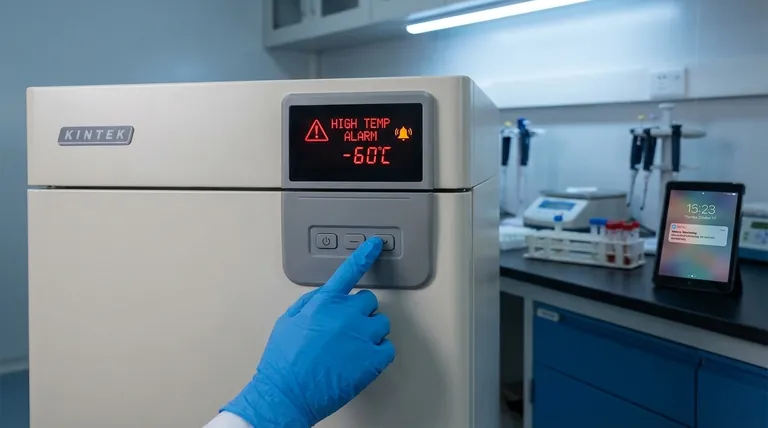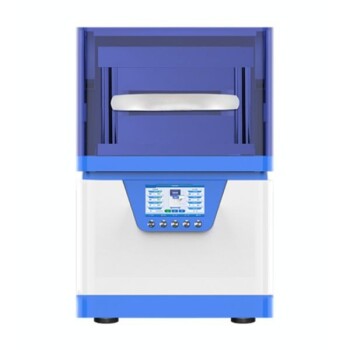In short, the alarm system in an ultra-low temperature (ULT) freezer is a critical safety feature designed to provide immediate alerts for any condition that threatens your samples. It monitors for dangerous temperature changes, power outages, internal system malfunctions, and simple human errors like a door being left ajar.
A ULT freezer's alarm system is not just a feature; it is the first line of defense in a comprehensive strategy to protect irreplaceable biological materials. Its primary purpose is to transform a potential catastrophe into a manageable incident by providing timely warnings.

The Core Function: Immediate Threat Detection
The fundamental job of a ULT freezer alarm is to alert you the moment sample integrity is at risk. This is accomplished by monitoring several key operational parameters.
Temperature Deviation Alerts
This is the most critical alarm. It triggers if the internal temperature rises above or falls below a predefined set point, indicating a cooling problem or a faulty controller.
Power Failure Alerts
The system will alert you if the main power supply to the unit is cut. This is crucial as it gives you a chance to intervene before the internal temperature begins to rise significantly. These alarms are powered by a built-in battery backup.
System Failure Alerts
Modern freezers run internal diagnostics. An alarm will sound if a critical component, like a compressor, sensor, or fan, is failing. This provides a proactive warning before a complete temperature failure occurs.
Door Ajar Alerts
A simple but devastatingly common problem is a door not being sealed properly. An alarm will trigger if the door is left open for more than a brief period, preventing the slow ingress of warm, moist air that can compromise samples and cause ice buildup.
Remote Monitoring and Notification
Basic alarms are audible and visual alerts on the unit itself. However, most modern ULT systems can be connected to a network to send automated notifications via email or text message to designated personnel, ensuring an incident is never missed.
Beyond Alarms: A System-Wide Approach to Safety
While alarms are your notification system, the freezer's underlying design provides the resilience needed to give you time to respond. The alarm is one part of a multi-layered safety net.
Redundancy with Dual Cooling Systems
Many high-security ULT freezers feature two independent refrigeration systems. If one system fails, the backup system automatically takes over, typically maintaining the temperature around -65°C. This doesn't stop the alarm, but it prevents total sample loss and provides a much larger window for repairs.
The Role of High-Performance Insulation
Advanced vacuum-insulated panels and high-density foam are not just for energy efficiency. In a power outage, superior insulation dramatically slows the rate at which the freezer warms up, extending the time you have to respond to an alarm before the temperature reaches a critical level.
Understanding the Limitations
No system is foolproof, and relying on alarms without a plan can lead to a false sense of security.
False Alarms and Alarm Fatigue
If an alarm's parameters are set too sensitively, it can lead to frequent false alarms. This can cause "alarm fatigue," where personnel begin to ignore or mistrust the warnings, which is a significant operational risk.
Dependency on External Systems
Remote notifications are incredibly valuable, but they rely on your facility's Wi-Fi, cellular service, and power. A network outage can silence a remote alarm, making on-site visual and audible alerts just as critical.
The Human Element Is Paramount
An alarm is only as effective as the response to it. Without a clear, documented, and regularly practiced emergency plan, an alarm is simply a noise. Everyone must know who to contact and what steps to take for each type of alert.
Making the Right Choice for Your Goal
When evaluating a ULT freezer, consider how its alarm and safety systems align with your specific priorities.
- If your primary focus is protecting irreplaceable samples: Prioritize a freezer with a dual cooling system and robust remote alarm notifications that can be sent to multiple people.
- If your primary focus is operational reliability: Ensure you have a clear and tested response plan for every alarm type, and confirm that the freezer's alarm system has a reliable battery backup.
- If your primary focus is ensuring basic protection: At a minimum, choose a unit with clear, loud, on-board audible and visual alarms for high temperature and power failure.
Ultimately, a ULT freezer's alarm system is a vital tool, but proactive management is what truly guarantees the safety of your work.
Summary Table:
| Alarm Feature | Function | Key Benefit |
|---|---|---|
| Temperature Deviation | Triggers if temperature exceeds set points | Prevents sample degradation from cooling failures |
| Power Failure | Alerts when main power is lost (battery-backed) | Early warning to intervene before temperature rises |
| System Failure | Monitors components like compressors and sensors | Proactive alert for hardware issues before total failure |
| Door Ajar | Detects improperly sealed doors | Prevents warm air ingress and ice buildup |
| Remote Monitoring | Sends email/text alerts via network connection | Ensures incidents are never missed, even off-site |
Ensure your laboratory's critical samples are protected with reliable ULT freezer solutions from KINTEK.
Our ultra-low temperature freezers are engineered with advanced alarm systems and safety features—like dual cooling redundancy and high-performance insulation—to give you peace of mind and time to respond in emergencies. Whether you're storing irreplaceable biological materials or prioritizing operational uptime, KINTEK provides lab equipment designed for precision, durability, and sample security.
Don’t leave your samples at risk. Contact our experts today to find the ideal ULT freezer tailored to your lab’s specific safety requirements.
Visual Guide

Related Products
- 508L Advanced Vertical Ultra Low Temperature Freezer for Critical Laboratory Storage
- 408L Advanced Vertical Laboratory Ultra Low Temperature Freezer for Critical Research Material Preservation
- 58L Precision Laboratory Ultra Low Temperature Upright Freezer for Critical Sample Storage
- 158L Precision Vertical Ultra Low Freezer for Laboratory Applications
- 808L Precision Laboratory Vertical Ultra Low Temperature Freezer
People Also Ask
- What are ultra low temperature freezers used for? Preserving Critical Biological Samples for Decades
- What factors should be considered when selecting an ultra-low temperature freezer? Ensure Sample Integrity and Long-Term Value
- What is the price range for ultra low temperature freezers? Protect Your Samples with the Right Investment
- In what fields are ultra low temperature freezers most commonly used? Essential for Biomedical, Clinical, and Research Labs
- What makes Ultra-Low Temperature freezers energy efficient? Key Design & Operational Strategies



















